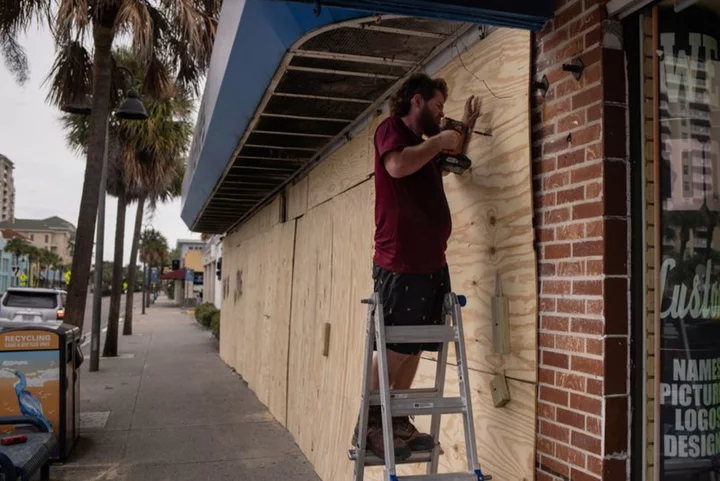By Maria Alejandra Cardona and Marco Bello
STEINHATCHEE, Florida Florida's Gulf Coast braced on Wednesday for fierce winds, torrential rain and surging seawater from Idalia, forecast to become "an extremely dangerous" Category 4 hurricane, as it swirled toward a direct hit on the state's Big Bend region.
Idalia's fury steadily intensified on Tuesday, drawing energy from the warm, open waters of the Gulf of Mexico, while millions of people in the storm's path tied down boats, boarded up windows, sandbagged their properties and headed for higher ground.
Mandatory evacuation orders had been issued in at least 28 of Florida's 67 counties as of Tuesday night.
"If you have not evacuated, you need to do that right now," Florida emergency management chief Kevin Guthrie said during an evening news briefing. "You need to drop what you're doing. You need to go to your room, pack up, pack your things and get to safety."
Most of Florida's 21 million residents, and many in the adjacent states of Georgia and South Carolina, were under hurricane warnings and other storm-related advisories. State emergency declarations were issued in all three.
"They're expecting some fatalities, so I don't want to be one of them," Rene Hoffman, 62, said as she readied to leave her home in Steinhatchee, Florida, which is in the projected landfall zone. She owns a food stand that she lashed to her husband's pickup truck to keep it from washing or blowing away.
Idalia was forecast to attain "an extremely dangerous Category 4 intensity" on the five-step Saffir-Simpson wind scale by the time it makes landfall in Florida Wednesday morning, the National Hurricane Center (NHC) in Miami said Tuesday night.
At last report from the hurricane center, Idalia was packing maximum sustained winds of 110 miles per hour (177 kph), at the upper end of a Category 2, as it churned toward shore 120 miles (193 km) southwest of Cedar Key, Florida. Any storm reaching Category 3 or higher is considered a major hurricane.
Florida's Gulf Coast, southeastern Georgia and eastern parts of North and South Carolina could face 4 to 8 inches (10 to 20 cm) of rain through Thursday, with isolated areas seeing as much as a foot of rain (30 cm), the hurricane center warned.
Officials said the storm's most dangerous feature would be a powerful surge of wind-driven surf that is expected to flood barrier islands and other low-lying areas along the coast.
Surge warnings were posted for hundreds of miles of shoreline, from Sarasota to the sport fishing haven of Indian Pass at the western end of Apalachicola Bay. In some areas, depending on tides, the surge of water could rise 10 to 15 feet (3.0 to 4.6 m), the NHC said.
"The No. 1 killer in all of these storms is water," Deanne Criswell, the Federal Emergency Management Agency's administrator, said on CNN.
The NHC said Idalia's center would most likely cross Florida's shoreline somewhere in the Big Bend region, where the state's northern Gulf Coast panhandle curves into the western side of the Florida Peninsula, roughly bounded by the inland cities of Gainesville and Tallahassee, the state capital.
Sparsely populated compared with the Tampa-St. Petersburg area to the south, the Big Bend features a marshy coast, threaded with freshwater springs and rivers, and a cluster of small offshore islands forming Cedar Key, a historic fishing village demolished in 1896 by a hurricane's storm surge.
At the White House on Tuesday, U.S. President Biden said he and Florida Governor Ron DeSantis, who is seeking the Republican nomination to challenge Biden in the 2024 presidential election, were "in constant contact" about storm preparations.
Idalia-related disruptions extended to Florida's Atlantic coast at Cape Canaveral, where the Tuesday launch of a rocket carrying a U.S. Space Force intelligence satellite was delayed indefinitely.
Idalia grew from a tropical storm into a hurricane early on Tuesday, a day after passing west of Cuba, where it damaged homes, knocked out power, flooded villages and prompted mass evacuations.
It was fourth major hurricane to strike Florida in the past seven years, following Irma in 2017, Michael in 2018 and Ian, which peaked at Category 5, last September.
More than 40 school districts in Florida canceled classes, DeSantis said, and Tampa International Airport suspended commercial operations on Tuesday.
About 5,500 National Guard members were mobilized, while 30,000 to 40,000 electricity workers were on standby. The state has set aside 1.1 million gallons of gasoline to address any interruptions to fuel supplies, the governor said.
In Sarasota - a city hard-hit by Ian last year - Milton Bontrager, 40, who runs a charter fishing service near Tampa, said his home was boarded up and stocked with food, water and a generator, and his boats were secure.
"I don't panic, I prepare," he said on Tuesday.
(Reporting by Maria Alejandra Cardona in Steinhatchee, Florida, Marco Bello in Cedar Key, Florida, Joey Roulette in Tampa, Florida, Rich McKay in Atlanta, Nelson Acosta in Havana, Dave Sherwood in Guanimar, Cuba, Brad Brooks in Longmont, Colorado, Brendan O'Brien in Chicago and Nandita Bose in Washington; Writing by Steve Gorman; Editing by Gerry Doyle)

